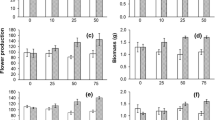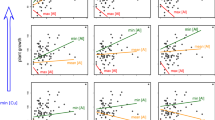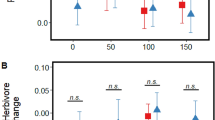Abstract
Background
Metal hyperaccumulators are plant species that can uptake and store high concentrations of heavy metals in their aboveground tissues, while maintaining high vigor. Hyperaccumulation of metals was suggested to provide defense against natural enemies such as herbivores. However, heavy-metal uptake can incur physiological and ecological costs, suggesting that, like other anti-herbivore defenses, it might be induced by herbivore attack. Nevertheless, this idea has been scarcely studied.
Methods
We tested the hypothesis that herbivory could induce enhanced metal uptake in Helianthus annuus, which can accumulate high amounts of heavy metals in its aboveground tissues and is commonly used for phytoremediation of heavy-metal contaminated soils. In a greenhouse experiment, H. annuus plants were grown in low or high soil cadmium (Cd) concentration and subjected to control or herbivory treatments. Herbivory was simulated using both leaf damage and exogenous application of jasmonic acid, which activates anti-herbivore defenses in plants.
Results
Simulated herbivory increased Cd concentration in the leaves of H. annuus by 24 and 39% under low and high soil Cd availability, respectively. Moreover, while simulated herbivory decreased shoot biomass of H. annuus it resulted in increased total Cd uptake. These results demonstrate that hyperaccumulation of heavy metals might be a facultative trait, whose extent can be enhanced in response to herbivore damage.
Conclusions
This study provides first evidence that simulated herbivory can enhance total heavy metal uptake in plants that are used for remediation of contaminated soils, which can have important implications on the optimization of phytoremediation practices.


Similar content being viewed by others
Data availability
The data generated during the current study are available as Supplementary Information.
References
Ali H, Khan E, Sajad MA (2013) Phytoremediation of heavy metals—concepts and applications. Chemosphere 91:869–881
Angle JS, Linacre NA (2005) Metal phytoextraction—a survey of potential risks. Int J Phytoremed 7:241–254
Baldwin IT, Schmelz EA, Ohnmeiss TE (1994) Wound-induced changes in root and shoot jasmonic acid pools correlate with induced nicotine synthesis in Nicotiana sylvestris spegazzini and comes. J Chem Ecol 20:2139–2157
Bar M, Shtein I (2019) Plant trichomes and the biomechanics of defense in various systems, with solanaceae as a model. Botany 97:651–660
Bazzaz FA, Chiariello NR, Coley PD, Pitelka LF (1987) Allocating resources to reproduction and defense. BioScience 37:58–67
Behmer S, Lloyd C, Raubenheimer D, Stewart-Clark J, Knight J, Leighton R, Harper F, Smith J (2005) Metal hyperaccumulation in plants: mechanisms of defence against insect herbivores. Funct Ecol 19:55–66
Benavides BJ, Drohan P, Spargo JT, Maximova S, Guiltinan M, Miller D (2021) Cadmium phytoextraction by Helianthus annuus (sunflower), Brassica napus cv Wichita (rapeseed), and Chyrsopogon zizanioides (vetiver). Chemosphere 265:129086
Blamey F, Joyce D, Edwards D, Asher C (1986) Role of trichomes in sunflower tolerance to manganese toxicity. Plant Soil 91:171–180
Boughton AJ, Hoover K, Felton GW (2005) Methyl jasmonate application induces increased densities of glandular trichomes on tomato, Lycopersicon esculentum. J Chem Ecol 31:2211–2216
Boyd RS (2004) Ecology of metal hyperaccumulation. New Phytol 162:563–567
Boyd RS (2007) The defense hypothesis of elemental hyperaccumulation: status, challenges and new directions. Plant Soil 293:153–176
Boyd R, Martens S (1992) The raison d’être for metal for metal hyperaccumulation by plants. In: Baker A, Proctor J, Reeves R (eds) The vegetation of ultramafic (serpentine) soils. Intercept, Andover
Boyd RS, Martens SN (1998) The significance of metal hyperaccumulation for biotic interactions. Chemoecology 8:1–7
Cappa JJ, Pilon-Smits EA (2014) Evolutionary aspects of elemental hyperaccumulation. Planta 239:267–275
Cipollini D (2007) Consequences of the overproduction of methyl jasmonate on seed production, tolerance to defoliation and competitive effect and response of Arabidopsis thaliana. New Phytol 173:146–153
Dar TA, Uddin M, Khan MMA, Hakeem K, Jaleel H (2015) Jasmonates counter plant stress: a review. Environ Exp Bot 115:49–57
Davis MA, Boyd RS (2000) Dynamics of Ni-based defence and organic defences in the Ni hyperaccumulator, Streptanthus polygaloides (Brassicaceae). New Phytol 146:211–217
El-Tayeb M, El-Enany A, Ahmed N (2006) Salicylic acid-induced adaptive response to copper stress in sunflower (Helianthus annuus L.). Plant Growth Regul 50:191–199
Farooq MA, Gill RA, Islam F, Ali B, Liu H, Xu J, He S, Zhou W (2016) Methyl jasmonate regulates antioxidant defense and suppresses arsenic uptake in Brassica napus L. Front Plant Sci 7:468
Goolsby EW (2016) Evolution of heavy metal hyperaccumulation in wild sunflowers (Helianthus). University of Georgia, Athens
Goolsby EW, Mason CM (2015) Toward a more physiologically and evolutionarily relevant definition of metal hyperaccumulation in plants. Front Plant Sci 6:33
Göpfert J, Heil N, Conrad J, Spring O (2005) Cytological development and sesquiterpene lactone secretion in capitate glandular trichomes of sunflower. Plant Biol 7:148–155
Guarino C, Sciarrillo R (2017) Effectiveness of in situ application of an integrated phytoremediation system (IPS) by adding a selected blend of rhizosphere microbes to heavily multi-contaminated soils. Ecol Eng 99:70–82
Hall CR, Waterman JM, Vandegeer RK, Hartley SE, Johnson SN (2019) The role of silicon in antiherbivore phytohormonal signalling. Front Plant Sci 10:1132
Hanson B, Lindblom SD, Loeffler ML, Pilon-Smits EA (2004) Selenium protects plants from phloem-feeding aphids due to both deterrence and toxicity. New Phytol 162:655–662
Herde O, Pena-Cortes H, Willmitzer L, Fisahn J (1997) Stomatal responses to jasmonic acid, linolenic acid and abscisic acid in wild-type and ABA-deficient tomato plants. Plant Cell Environ 20:136–141
Johnson MT, Campbell SA, Barrett SC (2015) Evolutionary interactions between plant reproduction and defense against herbivores. Annu Rev Ecol Evol Syst 46:191–213
Johnson SN, Rowe RC, Hall CR (2020) Silicon is an inducible and effective herbivore defence against Helicoverpa punctigera (Lepidoptera: Noctuidae) in soybean. Bull Entomol Res 110:417–422
Karasov TL, Chae E, Herman JJ, Bergelson J (2017) Mechanisms to mitigate the trade-off between growth and defense. Plant Cell 29:666–680
Karban R (2011) The ecology and evolution of induced resistance against herbivores. Funct Ecol 25:339–347
Kazemi-Dinan A, Thomaschky S, Stein RJ, Krämer U, Müller C (2014) Zinc and cadmium hyperaccumulation act as deterrents towards specialist herbivores and impede the performance of a generalist herbivore. New Phytol 202:628–639
Kempel A, Schädler M, Chrobock T, Fischer M, van Kleunen M (2011) Tradeoffs associated with constitutive and induced plant resistance against herbivory. Proc Natl Acad Sci 108:5685–5689
Li C, Wang P, Menzies NW, Lombi E, Kopittke PM (2017) Effects of changes in leaf properties mediated by methyl jasmonate (MeJA) on foliar absorption of Zn, Mn and Fe. Ann Bot 120:405–415
Li C, Wang P, Menzies NW, Lombi E, Kopittke PM (2018) Effects of methyl jasmonate on plant growth and leaf properties. J Plant Nutr Soil Sci 181:409–418
Maksymiec W, Krupa Z (2002) Jasmonic acid and heavy metals in Arabidopsis plants-a similar physiological response to both stressors? J Plant Physiol 159:509–515
Manara A, Fasani E, Furini A, DalCorso G (2020) Evolution of the metal hyperaccumulation and hypertolerance traits. Plant Cell Environ 43:2969–2986
Mason CM, Bowsher AW, Crowell BL, Celoy RM, Tsai CJ, Donovan LA (2016) Macroevolution of leaf defenses and secondary metabolites across the genus Helianthus. New Phytol 209:1720–1733
Mohiley A, Tielbörger K, Seifan M, Gruntman M (2020) The role of biotic interactions in determining metal hyperaccumulation in plants. Funct Ecol 34:658–668
Mohiley A, Laaser T, Höreth S, Clemens S, Tielbörger K, Gruntman M (2021) Between the devil and the deep blue sea: herbivory induces foraging for and uptake of cadmium in a metal hyperaccumulating plant. Proc R Soc B 288:20211682
Pilon-Smits E (2005) Phytoremediation. Annu Rev Plant Biol 56:15–39
Rascio N, Navari-Izzo F (2011) Heavy metal hyperaccumulating plants: how and why do they do it? And what makes them so interesting? Plant Sci 180:169–181
Rizwan M, Ali S, ur Rehman MZ, Rinklebe J, Tsang DC, Bashir A, Maqbool A, Tack F, Ok YS (2018) Cadmium phytoremediation potential of Brassica crop species: a review. Sci Total Environ 631:1175–1191
Rowe HC, Ro D-k, Rieseberg LH (2012) Response of sunflower (Helianthus annuus L.) leaf surface defenses to exogenous methyl jasmonate. PLoS One 7:e37191
Strauss SY, Rudgers JA, Lau JA, Irwin RE (2002) Direct and ecological costs of resistance to herbivory. Trends Ecol Evol 17:278–285
Suhita D, Raghavendra AS, Kwak JM, Vavasseur A (2004) Cytoplasmic alkalization precedes reactive oxygen species production during methyl jasmonate-and abscisic acid-induced stomatal closure. Plant Physiol 134:1536–1545
Thaler JS (1999) Induced resistance in agricultural crops: effects of jasmonic acid on herbivory and yield in tomato plants. Environ Entomol 28:30–37
Thaler JS, Stout MJ, Karban R, Duffey SS (2001) Jasmonate-mediated induced plant resistance affects a community of herbivores. Ecol Entomol 26:312–324
Van der Ent A, Baker AJ, Reeves RD, Pollard AJ, Schat H (2013) Hyperaccumulators of metal and metalloid trace elements: facts and fiction. Plant Soil 362:319–334
van Kleunen M, Ramponi G, Schmid B (2004) Effects of herbivory simulated by clipping and jasmonic acid on Solidago canadensis. Basic Appl Ecol 5:173–181
Vesk PA, Reichman SM (2009) Hyperaccumulators and herbivores-a bayesian Meta-analysis of feeding choice trials. J Chem Ecol 35:289–296
Wasternack C, Parthier B (1997) Jasmonate-signalled plant gene expression. Trends Plant Sci 2:302–307
Xiu-Zhen H, Dong-Mei Z, Dan-Dan L, Jiang P (2012) Growth, cadmium and zinc accumulation of ornamental sunflower (Helianthus annuus L.) in contaminated soil with different amendments. Pedosphere 22:631–639
Yan A, Wang Y, Tan SN, Yusof MLM, Ghosh S, Chen Z (2020) Phytoremediation: a promising approach for revegetation of heavy metal-polluted land. Front Plant Sci 11:359
Yang D-L, Yao J, Mei C-S, Tong X-H, Zeng L-J, Li Q, Xiao L-T, Sun T-p, Li J, Deng X-W (2012) Plant hormone jasmonate prioritizes defense over growth by interfering with gibberellin signaling cascade. Proc Natl Acad Sci 109:E1192–E1200
Zavala JA, Baldwin IT (2006) Jasmonic acid signalling and herbivore resistance traits constrain regrowth after herbivore attack in Nicotiana attenuata. Plant Cell Environ 29:1751–1760
Zhao Q, Sun Q, Dong P, Ma C, Sun H, Liu C (2019) Jasmonic acid alleviates boron toxicity in Puccinellia tenuiflora, a promising species for boron phytoremediation. Plant Soil 445:397–407
Acknowledgements
We are grateful to Ruth Gottlieb, Inbal Eilon-First, Golan Zimmerman, and Snir Weintrob for their assistance with logistics and experimental setup, and to Zhanna Kats, Karina Gitin Heskiau, Ran Tal and Aviv Kaplan for their help with preparations and sample analysis. We would also like to thank the Laboratory of Environmental Bioengineering, the Hydrochemistry Laboratory and the Shenkar Laboratory at Tel Aviv University for allowing us to use their facilities. We are thankful to Yarok Organic Nursery for supplying us with sunflower seedlings.
Funding
This study was supported by a grant of the Israeli Science Foundation (ISF) to MG (grant 2904/19) and a fellowship of the Smaller-Winnikow Fund for Environmental Research to EG.
Author information
Authors and Affiliations
Contributions
EG and MG conceived the project and designed the experiment; EG performed the experiment and collected and analyzed the data; EG and MG wrote the manuscript.
Corresponding author
Ethics declarations
The authors have no relevant financial or non-financial interests to disclose.
Competing interests
The authors declare that they have no conflict of interest.
Additional information
Responsible Editor: Antony Van der Ent.
Publisher’s note
Springer Nature remains neutral with regard to jurisdictional claims in published maps and institutional affiliations.
Supplementary Information
Below is the link to the electronic supplementary material.
Rights and permissions
Springer Nature or its licensor holds exclusive rights to this article under a publishing agreement with the author(s) or other rightsholder(s); author self-archiving of the accepted manuscript version of this article is solely governed by the terms of such publishing agreement and applicable law.
About this article
Cite this article
Grossman, E., Gruntman, M. Simulated herbivory enhances Cd phytoextraction efficiency of sunflowers. Plant Soil 481, 385–394 (2022). https://doi.org/10.1007/s11104-022-05643-7
Received:
Accepted:
Published:
Issue Date:
DOI: https://doi.org/10.1007/s11104-022-05643-7




